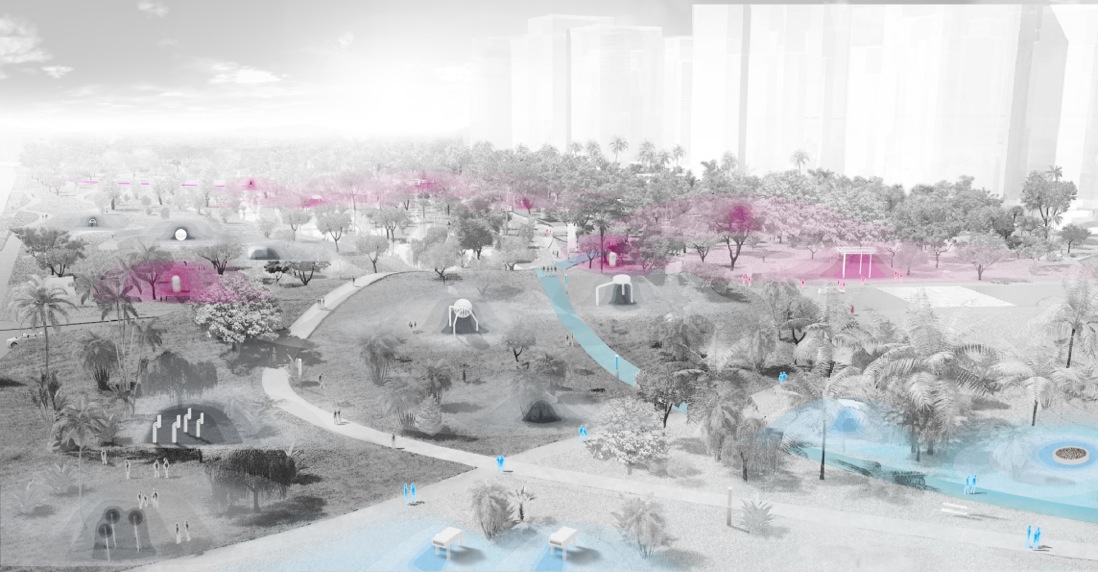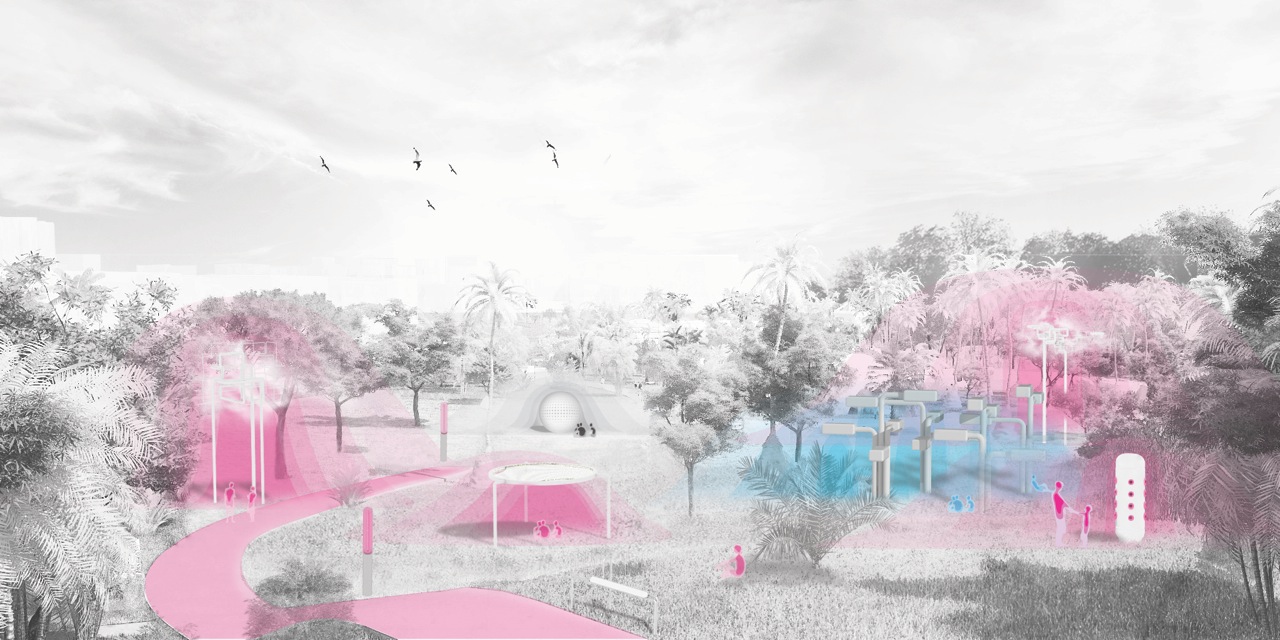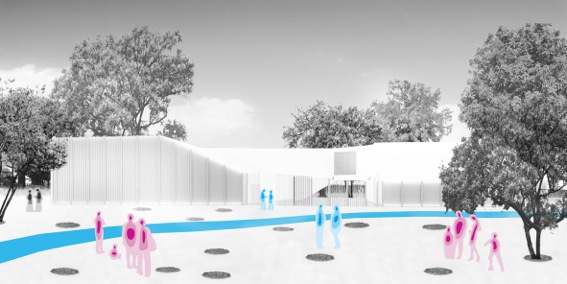
click
images fullscreen
< > 1 2 3
Jade Eco Park
Landscape and architectural design for a new 70-hectare park on the site of the old airport, with leisure, sport, family and tourist activities, a 3000 m2 visitor center, a maintenance center, and the urban regulation for a new museum and the Taiwan towerThe ambition of our project is to give back the outdoors to the inhabitants and visitors by proposing to create exterior spaces where the excesses of the subtropical warm and humid climate of Taichung are lessened. The exterior climate of the park is thus modulated so to propose spaces less hot (more cold, in the shade), less humid (by lowering humid air, sheltered from the rain and flood) and less polluted (by adding filtered air from gases and particle matters pollution, less noisy, less mosquitoes presence). The design composition principle of the «Taichung Jade MeteoPark» is based on climatic variations that we have mapped by computational fluid dynamics simulation (CFD): some areas of the park are naturally warmer, more humid and more polluted while some of them are naturally colder (because they are in the route of cold winds coming from the North), dryer (because protected from the south-west wind provinding humidity of the see in the air) and cleaner (faraway from the roads). We have augmented these differences of microclimates in order to increase the coolness, the dryness, the cleaness of the places that are naturally cooler, less humid and less polluted, for creating more comfortable spaces for the visitors. Beginning with the existing climatic conditions as a point of departure we have defined three gradation climatic maps following the results of three computational fluid dynamics simulations. Each map specifically corresponds to a particular atmospheric parameter and it variation of intensity thoughtout the park. The first one corresponds to variation on the heat on the site, the second one describes the variations in humidity in the air and the third one the intensity of the atmospheric pollution. Each map shows how the intensity or strength of the respective atmospheric parameter is modulated through the park. By doing so the maps keep areas within the park from reaching excessive natural conditions while making the experience of changes in climate much more comfortable in the areas where we will reinforce the coolness, the dryness, the cleaness. The three maps intersect and overlap randomly in order to create a diversity of microclimates and a multitude of different sensual experiences in different areas of the park that we could freely occupy depending the hour of the days or the month in the year. At a certain place for example, the air will be less humid and less polluted but it will still be warm, whilst elsewhere in the park, the air will be cooler and dryer, but will remain polluted. The three climatic maps vary within a gradation, which ranges from a maximum degree of uncomfortable atmospheric levels that usually exist in the city (maximum rate of pollution, maximum rate of humidity, maximum rate of heat) to areas that are more comfortable where the heat, the humidity and the pollution are lessened.
To materialize these climatic maps, we invented a catalogue of climatic devices (natural and artificial) that reinforce areas that are already more comfortable by lowering, reducing, inverting, and diminishing the heat, humidity and pollution. These devices are classified in three categories: the cooling devices, the drying devices, the depolluting devices.
The natural cooling devices are trees with specific qualities for cooling the atmosphere because they have a lots of leaves or big leaves that create heavy shadows, or white flowers and waxy white leaves in order to reflecte the warm sun rays, or trees that produce a strong evaporation with consequence to cool the air around because of the physical change of phase from liquide to gas. The artificial cooling devices are apparatus working on meteorological phenomena like convection, conduction, evaporation or reflection in order to cool the air or directly the human body. The convective cooling devices are named "Antycyclone" or "Underground breeze" and they blow cool air chilled by underground heat exchange. The conductive cooling devices are named "Night light" or "Vertical night" and expose black and cold surface chilled by cold water where the human skin can be cooled by touching them. The evaporating cooling devices are named for exemple "Stratus cloud" or "Blue sky drizzle" and by emitting mist or rain, they refresh the surrounding air temperature by their change of phase from liquide to gas. The reflective cooling devices named "Moon light" or "Long waves filters" are apparatus that filter or reflecte the sunlight and the hat carried by it.
The second category of climatic devices are the drying climatic devices which objectives are to protect the body from the rain and to reduce the excess of humidity in the air that amplify the uncomfort by an unfavorable influence on the human body in the thermolysis process by blocking perspiration. The first objective is reached by artificial shelters and trees with dense frond that protect from the rain. The second objective is reached by natural drying climatic devices that absorb the humidity in the air with their floating roots and artificial drying devices that blow air dried by silicate gel exchangers named "Dry cloud" or "Desert wind".
The third category are the depolluting climatic devices. They reduce the atmopherical pollution in the air, the excess of the noise and presence of mosquitoes. The natural depolluting devices are composed by trees with capability to absorb oxides of nitrogen and other aerosols, to make effective sound barriers. The artifical depolutting devices like the "Ozone eclipse" for exemple blow in the park filtered air without gazeous pollution like Nox, O3 or S02. The "Preindustrial draught" blow in the park air without particle matters PM10 and PM2.5 emitted by the industry and cars. The Ultrasound Repellant device repels mosquitoes emitting waves, above the human auditory range (>20kHz), and at the same frequency as the beat of a dragonfly's wings. This will repel the mosquitos from the sounds of their predators.
According to the density and quantity of climatic devices in a given area, we create spaces more or less enjoyable, more or less comfortable, thus the different climatic properties sometimes overlap, separate, regroupe, densify, dilute, generating a variety of atmospheres where the users can choose and appropriate as they see fit.
2011 - First prize of the International competition
2012 - Preliminary design completed in December
2013 - Detailed design completed in June
2013 - Tender design completed in December
2014 - Construction starts in January
2016 - Construction completion
Video presentation of the project
team
Philippe Rahm architectes, Mosbach paysagistes, Ricky Liu & Associatesclient
Taichung City Govermentlocation, date
Taichung, Taiwan, 2012–2016^

